A Dancer’s Journey: Injury, Healing and Launching a Groundbreaking GYROTONIC® Rehabilitation Program for Professional Dancers
Blog Content Interviews // June 26, 2025
Anneli Chasemore is a professionally trained dancer from the English National Ballet School. She had a successful career across Europe but faced a turning point after a severe on-stage injury. Her journey to recovery led her to the GYROTONIC® Method, recommended to her by a forward-thinking orthopedic consultant in Cologne. Anneli’s remarkable recovery through Gyrotonic movement not only restored her physical capabilities but also transformed her approach to dance and injury prevention. She transitioned into teaching and became a strong advocate for the Gyrotonic Method, eventually helping to establish a health department for dancers at the Staatsballett in Berlin, Germany. This initiative provides holistic support (including injury prevention, nutritional advice, and psychological tools) specifically benefiting dancers. Anneli’s work has gained much recognition, making a substantial impact on dance rehabilitation and highlighting the importance of comprehensive, specialized care in maintaining dancers’ health and performance.
Dancing & Injury History
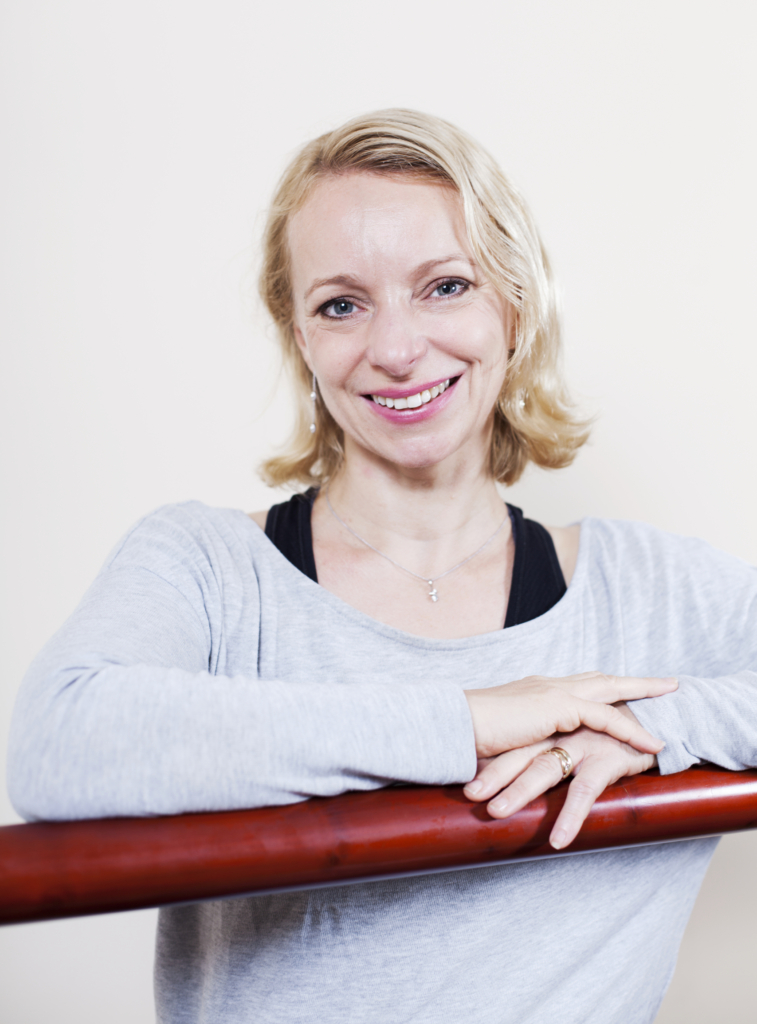
Anneli Chasemore at Gyrotonic and Gyrokinesis studio GYROTONIC® Insel Berlin. Photos by Carlos Collado.
I trained as a professional dancer in England, at the English National Ballet School. I discovered the Gyrotonic Method when I was dancing with Scottish Ballet before I got injured. There was already a bit of Gyrotonic exercise going on there, and I tried it one time with a friend. It was kind of a one-off thing. I started training at the age of 11, then went on to be a professional dancer, in the UK, Germany, and Norway. I moved around a fair bit. I had a long dancing career of 19 years, relatively injury-free, except for one very large injury.
I dislocated my elbow whilst performing on stage. I slipped doing a pas de deux. We don’t really know if there was some makeup on the floor, but there’s also an awkward corner of the pointe shoe where I slipped, and I was off-balance. It was supposed to be an off-balance movement, but I caught myself on my left arm and it dislocated. I also tore the ligament that goes around the head of the radius, and a piece of bone was pulled away from the ulna. It was traumatic because it was in the middle of a show, and we couldn’t go on.
My whole treatment right after the injury was, well… it wasn’t dance specific. Nobody really looked at deep diagnostics until I was put in touch with an orthopedic consultant in Cologne, which was very far from where I was. I was in Bavaria at the time, but I went to her, and she recognized immediately the severity of the accident, and the risk of not dancing again. Long story short, I ended up having surgery. All of that was quite difficult, and the recovery process was more difficult.
I had all of those complications trying to find the right surgeon who was an elbow specialist. In the end I was operated on in Heidelberg, at an elbow and shoulder clinic. I remember that after the surgery, they were quite surprised at low long it took for the movement to come back…before I started the Gyrotonic rehabilitation process.
I started with physiotherapy. I wasn’t regaining the movement I really needed. It was so restricted, I was thinking, “Will I actually be able to have the mobility and ease of movement to dance at a high professional level again?” The doctor in Cologne, she was a great fan of the Gyrotonic exercise, and very understanding towards dance medicine. She was ahead at the time because now, in Germany, we have different rehab options where Gyrotonic classes are offered to dancers. Back then they weren’t. She said to me, “Can you come to Cologne?” I agreed. She replied, “Okay, come do Gyrotonic classes every day and we’ll see what happens in four weeks.”
Utilizing the Gyrotonic Method for Rehabilitation
My first session was remarkable for me. The right arm was fine. As I put my left arm on the machine, I was shaking, and the arm would hardly move. It’s distressing for a dancer. I tried two or three times with the guidance of a Trainer and on the fourth go, my arm stretched. It was phenomenal. There must have been a lot of scarred tissue and fasciae restricting the movement, then suddenly my arm moved. I took Gyrotonic classes for a month and I felt so good. I’ve never felt like that. I never felt so good as a dancer as I did at the end of those four weeks. It took awhile for me to do big lifts and to not be so frightened of my body. All the other things I had, like patellar tendonitis, disappeared because my body was realigned. Muscle groups were more balanced. I had learned so much. It was transformative.
It’s the fact that it’s not local, it’s embedded in the movement. You are opening the joint in the sense that, with physio, I was doing very isolated movements. I was doing supination and pronation, and flexion and extension. With Gyrotonic classes, I wasn’t forcing anything. I was gently stretching (around) the joint with the breath, supporting my whole body with a context that even though the method was completely new to me, it felt familiar. I had to place myself. I had to think about my whole body. I had to reflect on what I was doing. I think that’s what made the difference.
I continued with my career and came back to dancing. There wasn’t much Gyrotonic training in the city where I was, so I used to travel over to Berlin, to go to Gyrotonic class at least once a week. I felt like it was important to me as a dancer. Even if it was my only free day, I would go and do it. Then I would bring a little group of friends. We’d all start doing the trip, and my now-husband would come along too. The teachers at the studio said to me at one point, “You should think about doing the training, you really absorb it all.” I said, “Okay, I’m still dancing but I’ll start.” They told me, “You must do the foundation course if you can, in Münstertal, because you’ll love it!”
That’s what happened. I did the amazing Foundation Course with Gyrotonic Master Trainer, Gina Muensterkoetter. It was intense, but I had such a good time. Then I did my Apprenticeship and the Final Certificate Course. I continued dancing and slowly teaching people at the opera house (singers, dancers, and musicians, too). Then I was fully licensed to teach. The psychological stress of being injured was as big as the physical pain, so I was like, “I need to do something!” I knew with the Gyrotonic Method, I could make a huge difference, but I also wanted to study, and I wanted to go to university. So, I followed up with a Master’s Degree in Dance Science, which gave me a background in the whole performance enhancement side of things. Where sports science caters to the athletes, dance science caters to the needs of the dancers. I also did a pedagogical teaching diploma for dance.
Then, my journey kind of changed. I really wanted to support dancers. There are lots of dancers in Germany that don’t speak German and who are very young. I felt like their needs were not being addressed. So, how was I going to do this in Germany? And then one thing led to another.
Founding the Dancer’s Health Department
I was asked to be a mentor for a dancer from the Staatsballett Berlin, Germany’s biggest ballet company. It has almost 90 dancers. It has a huge repertoire between classical and contemporary pieces. You name it, Balanchine to Forsythe, to Mats Ek and Sharon Eyval, everything. I was mentoring a dancer who was doing a teaching diploma. She was looking at coaching and the effect of coaching on dancers’ progression in their careers. She said to me, “I’ve spoken about you to the directorship because I think we need to have health support, like a dancers’ health department. We think you’re the right person to establish it.”
Together with Soraya Bruno, my colleague, we founded the Health Department at the Staatsballett.
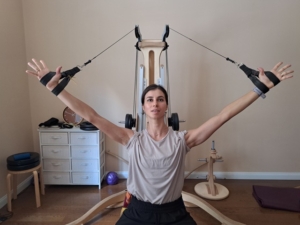
Rafaelle Quieroz, a dancer with Staatsballett Berlin at the end of her recovery from post OP shoulder rehabilitation, preparing to integrate into daily work.
As a team, we started small in 2016 (with a limited number of hours a week) working with dancers in all areas of performance enhancement and injury prevention. We have a great team of doctors and physiotherapists. One of the first things we established was a good network of team-players. The most important key partner is the famous hospital here in Berlin, Charité. They have a sport medicine department.
In Germany there’s a lot of awareness now in the sense of the issues, which kind of injuries are we seeing? There’s a huge study we were involved in along with five or six major ballet companies over a two-year period. They tracked injuries, but also the dancers did weekly monitoring where they tracked data. How many days did I dance with pain this week? How am I doing with that? How is my sleep quality? The data coming out is not that different from the data from similar research that was carried out earlier in other countries. It doesn’t look like things have changed in the way that things are getting significantly better (i.e., injury rates are not dropping).
Over the years, we’ve developed things, and we take care of dancers who notice they’ve got a little bit of pain, or some imbalance. They ask us to watch them in class to give them feedback, to look at the alignment, to give them special programs to support them. When they do get injured, they receive a lot of support. They also receive support on other things like nutritional advice, coaching for dancers, and psychological tools. The rehabilitation side has evolved immensely.
Germany has a special system, an insurance system, that when you’re employed, you have work accident insurance. So, when you have an accident at work (it must fall into certain categories) the insurance then normally pays for your treatment. Previously, you would get your surgery, medical treatment and physio paid for. You might, if you’re lucky, be sent to some rehabilitation center where you would do ergotherapy, physiotherapy, hydrotherapy, and conditioning, but it wouldn’t be specific to the needs of a dancer.
Over the years, Unfallkasse Berlin has been pivotal to all our developments. There’s a lady there, her name is Nicole Bauer, who’s been very forward-thinking. Ten years ago, she presented Gyrotonic class as a form of rehabilitation for dancers. She was already sending some dancers in Berlin to Gyrotonic studios. Once we had the dancers’ health department, we started to develop a much closer relationship with her. We have contact at least once a week. We speak about the specific needs of those dancers that have had an accident and are in their rehab. They receive guidance from step one.
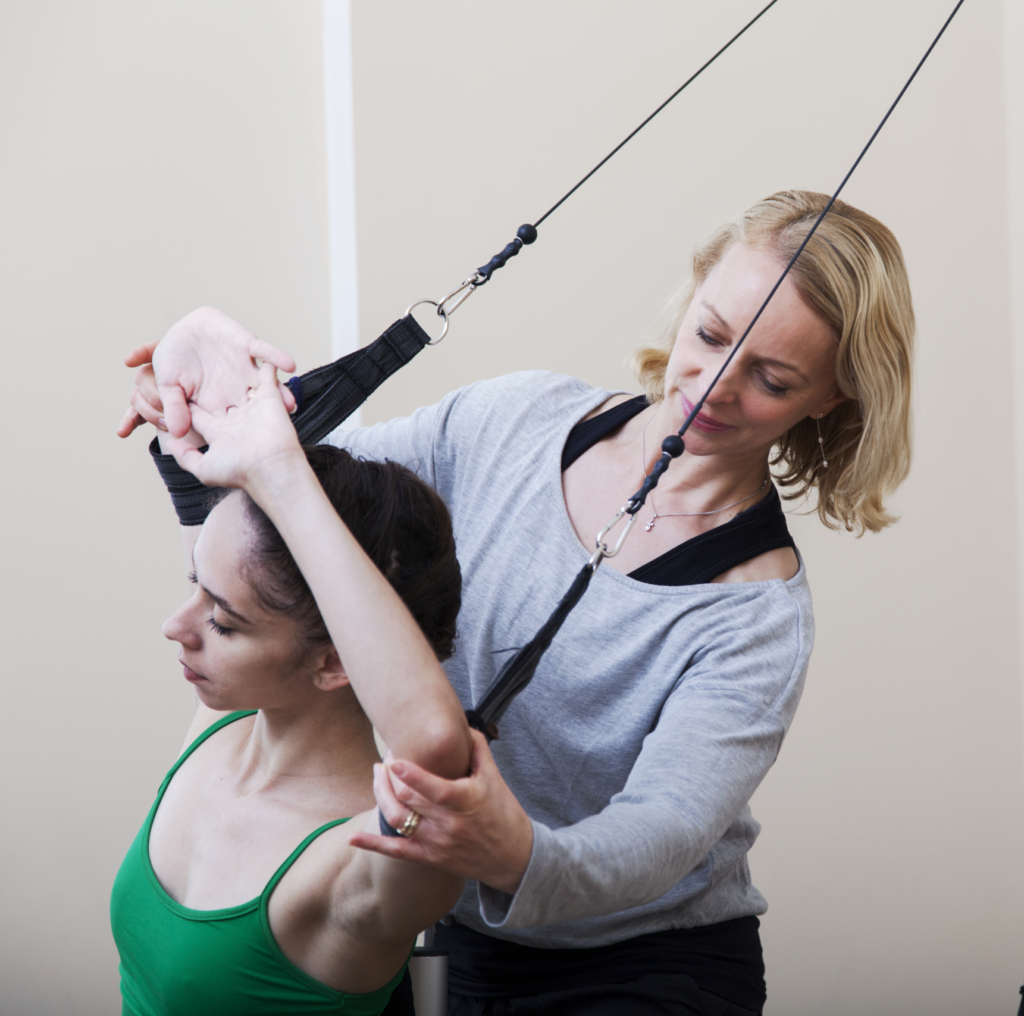
Gyrotonic and Gyrokinesis studio Gyrotonic Insel Berlin – Anneli Chasemore. Photos by Carlos Collado.
Your structure of life as a dancer is dictated by your schedule. We try to build a structure with them when they are in rehab so they, every day, have a good number of things, but not too many things. Some of them like to overload themselves, which can be detrimental. You must let what they’ve done sit and work. Dancers like to be very demanding of themselves. It’s all connected to your identity. It’s our livelihood. The body is our instrument, and it’s not like you can replace it easily. There is immediate fear you will lose your role because you must be replaced immediately. The work must continue. That’s hard for most dancers. There’s also the risk of not being able to come back to the level you were at. The stress is incredible.
We look at each case individually, then we talk to the dancer. They recieve rehab options and recommendations. We recommend, among other things, that they take Gyrotonic classes. They get two to three 90-minute sessions, two to three times a week. Nicole Bauer is also responsible for other dancers in the city. Berlin has a legendary revue theatre, The Friedrichstadt-Palast, where the dancers do everything from pointe shoes and high heels to acrobatics. They have seven shows a week! She’s also supporting them.
For example, we have a dancer who had a cruciate ligament injury. Nicole is so forward thinking she would say, “Okay, he’s injured his knee. His surgery is going to happen in so many weeks. What can we do to keep the rest of his body and psyche up?” Then she’ll say, “Okay…Gyrotonic sessions! Leave the knee out, don’t to anything that’s going to stress it.” Of course, there’s always a doctor involved, who’s also authorizing the Gyrotonic sessions. The whole thing accelerated the last two years. With Nicole Bauer already supporting Gyrotonic sessions, I didn’t need to convince her. She was already convinced before she met me. So that made life easier.
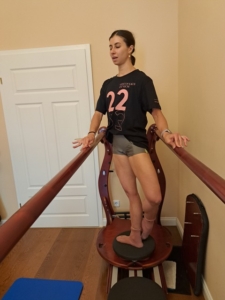
Rehabilitation on the Jumping Stretching Board. Image provided by Anneli Chasemore
It’s important to have an open mind, and to look at the whole picture. At first, the injured dancer is always a bit shocked. Then, they want to get the diagnostics done, know what they’ve got, and start dealing with it. They start to feel supported. You go through the ups and downs with them. As you take them through and eventually towards the end of the process, you help them move away from the healing/rehab phase and into the building up phase. That is when they need to think about agility and technique so you’re going on the Jumping-Stretching Board, and you start to add some of the dancer’s work so they can transition to ballet class smoothly. They can’t go into the studio until they can do all those things in a non-studio setting. The use of the cables, for example, connecting the port de bras, finding the scapula, finding the seed center, it’s all a huge part of it. There are a lot of dancers who dance fantastically but are not aware of those things. You come back a much better dancer if you can transfer Gyrotonic lessons into your dancing.
The first Hamburg Dance medicine symposium was established by Dr. Anja Hauschild, who is one of the passionate dance specialists in Germany. There’s a dance medicine society here, and she’s behind it (she’s also the one who set up the study with different ballet companies). There were invited speakers, all talking about dance injuries, and dance-specific rehabilitation. The dance rehabilitation center in Gelsenkirchen, Medicos, was there presenting their rehab as well as talking about their use of the Gyrotonic Method. I was there with Nicole Bauer, presenting how we go about dancer rehabilitation and how we’ve managed to get all these things supported.
We have tailor-made support for the dancers that’s very dance specific. We were able to introduce to other professionals and to regional work accident insurances exactly how we work, about the different stages of guidance throughout a dancer’s rehab. People were very excited. I showed a couple of videos of dancers practicing Gyrotonic sequences as a recovery from serious injury. That was Nicole Bauer’s wish. She felt it was important to see movement. She said, “It’s quite obvious when you see it, why it’s so beneficial.”
Dance Specific Rehabilitation
I have my own studio, and like most studios I have a wide range of clients.
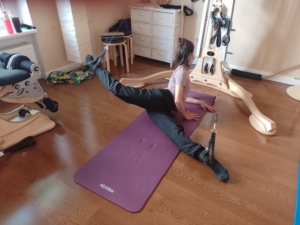
Image provided by Anneli Chasemore
In my studio (in Rehab supported by insurance), we have dancers (two cruciate ligaments, a dislocated shoulder), and a gymnast with the same injury as me (dislocated elbow). She’s an aerial gymnast and she’s made it back. She’s working again! We’ve had a freelance dancer being supported with a ruptured achilles tendon. We’ve had a dancer who had fallen down the stairs in the car park, with the ice in the winter, and had nasty back pain, and a dancer who had a motorbike accident on her way home from a performance.
With all clients, you must brief them, you must reflect on their progress. We’re seeing the dancers that are in rehab a lot. There’s a lot of updating going on and communication between us with the doctors or with the other team-players. What impressions do the physios have? What impression does the doctor have?
Things have taken place in a way that has been so fruitful. The Gyrotonic Method for dancers’ rehab is so beneficial. It feels like such a relief that it’s being recognized. It puts the Gyrotonic Method in the place where it should be. As a dancer, we have the whole body. It’s more than just rehabbing from the injury. I can start moving the injured part and regain range of motion, perhaps I can demonstrate what the doctors are asking me to do, but am I ready to transition back to class? There’s a return to sport, return to game, and a return to competition. We have a return to class and a return to the stage. Returning to class and the stage is one of the most complex bits because it takes a long time.
At the company, we have normally two ballet classes at a time, about 45 dancers in each class. It’s very stressful if you’re coming back from an injury. Everybody’s moving fast. It doesn’t matter how skilled the ballet masters are, they cannot give individual coaching with that number of people. So, the company now has a third class, a rehabilitative class, and it’s set to the needs of the dancers who are slowly transitioning back. There’s an information exchange going on there. We watch the class to observe and support them. They come back to the studio to take Gyrotonic classes, and then you can say, “Let’s work on this.”
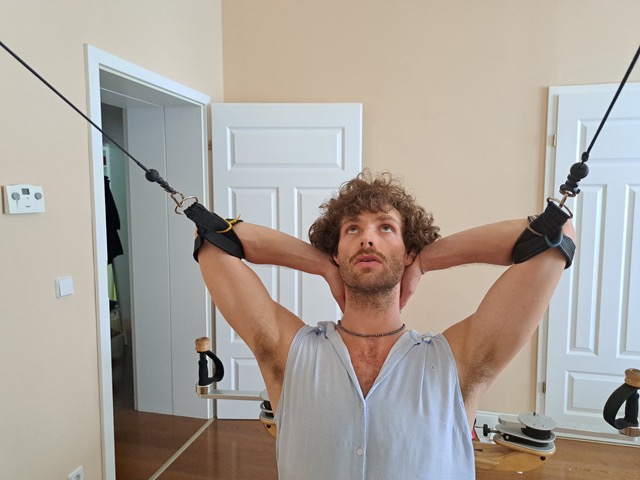
Sacha Males, a dancer with Staatsballett Berlin in rehab. Image provided by Anneli Chasemore.
The interesting thing is, everybody who’s gone down the Gyrotonic path can sing songs of this, but you watch them initially coming in for the injury and being focused on the injury. As they progress you start to address all the areas of the body, and they start to see the alignment, and other weak spots they hadn’t yet paid attention to. Gyrotonic training changes them a lot. It makes a big difference. It’s the way the Gyrotonic method works. It’s not forceful. They can work deeply, and they can feel strong, but they’re also nourished.
If you would like to take a session or Pre-Training Course with Anneli, visit Gyrotonic and Gyrokinesis studio Gyrotonicinselberlin or contact the studio directly. You can also learn more about Anneli and the Health Department at Staatsballett here.
Take a look at some other inspiring stories from our community:
Awareness and Imagination: The GYROKINESIS® Method from a Wheelchair
Running Reimagined: GYROTONIC® Techniques for Endurance and Agility
Training and Teaching with Physical Limitations
To find Gyrotonic and Gyrokinesis classes near you, you can use our Studio Finder tool.
To learn more about how to become a Gyrotonic or Gyrokinesis Trainer, visit our Teacher Training page.
